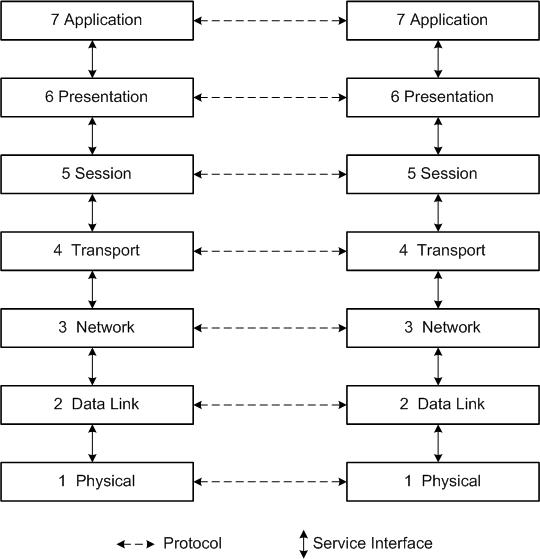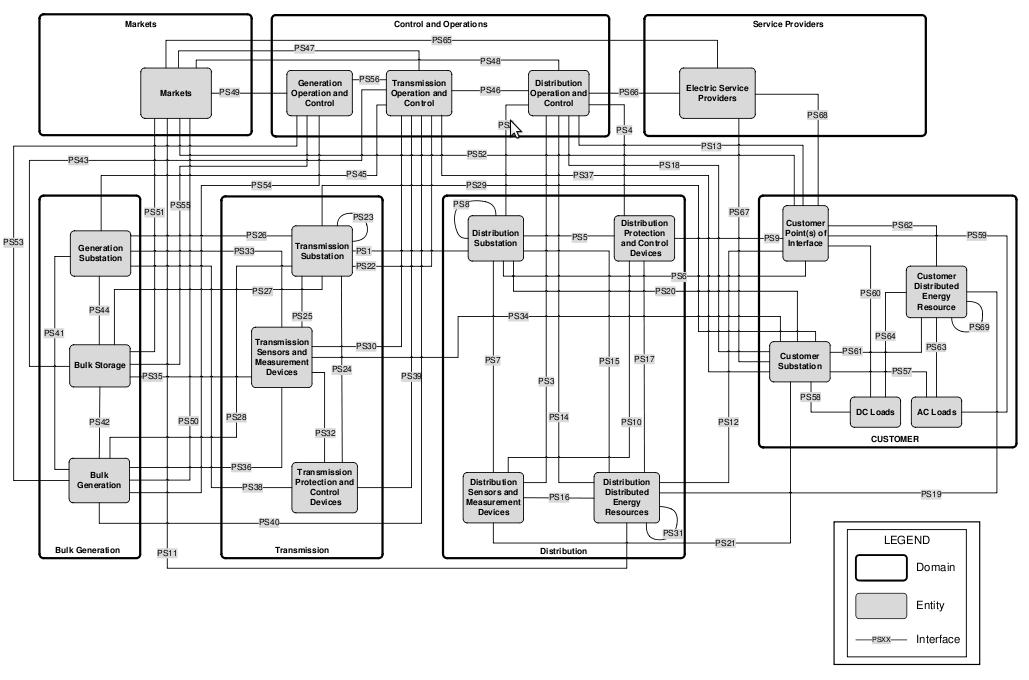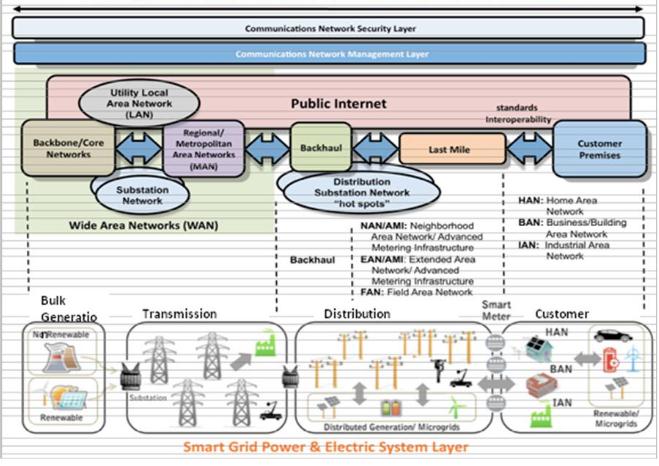|
|
Guide for Smart Grid interoperability
According to [1], no consensus has been reached on what the term Smart Grid exactly means. IEEE P2030 [2] is one of the first attempts to standardize what the Smart Grid is. It was first proposed in May 2009 to provide a knowledge base toward interoperability of the Smart Grid. The Smart Grid will generate a huge amount of data. In order to manage, store and effectively analyze this data, the power system, the communication architecture, and high level information technologies need to be coordinated as an integrated system of systems.
IEEE P2030 mainly provides a Smart Grid interoperability reference model (SGIRM) which identifies and defines generic interfaces between functional domains from three perspectives: the power system, the communication architecture, and the information technology. Since the number of different physical components, domains, and technologies is vast, the concept of interface is key to maintain important quality attributes such as interoperability, synchronicity, reliability, security, scalability and more. Interfaces are logical connections from one entity to another that supports one or more data flows implemented with one or more data links.
Each perspective is decomposed in 7 domains :
- Bulk generation: Components related to the generation facilities or storages directly connected to the grid.
- Transmission: Equipment associated with the electrical transmission system.
- Distribution: The main components are the distribution substation, lines with low voltage, transformers, etc.
- Customers: Entities connected to and using the electrical distribution system. There exist three customer types: residential, commercial, and industrial.
- Control and operation: Control and maintain the entire power system.
- Markets: Reflect the market operations associated with electric utilities.
- Service providers: Third-party electrical services.
Information and communications technology
Interoperability in information and communications technology (ICT) is generally improved by using the layered model of the International Organization for Standardization (ISO) Open Systems Interconnect (OSI) [3]. With this model, functionalities are separated into layers and layers are connected with service interfaces (Fig. 1).

Fig. 1. Open systems interconnect reference model [2].
The IEEE P2030 SGIRM concerns itself with information exchange at the ISO OSI model above the transport layer (layer 4). The focus of Smart Grid information technology interoperability is layers 4 through 7 and the focus of communication technology interoperability is layers 1 through 3.
Power system interoperability
The first Smart Grid perspective is the power system (Fig. 2). It represents the main entities of the electrical power system.

Fig. 2. Power system interoperability architectural perspectives for the Smart Grid [2].
As shown in Fig. 2, the future Smart Grid is complex in terms of interconnections between entities in several domains. If we focus on the customer domain, the main entity is the customer point of interface which is used to communicate with external entities outside the customer domain. The customer substation converts power to distribution voltage. AC/DC loads are electrical loads used by the customer.
The customer point of interface is connected to several entities through interfaces:
- Distribution substation: The Interface provides information for protection and about the customer.
- Distribution protection and control: Provide the capability to control devices, exchange information and monitor.
- Distribution distributed energy resources: Provide the capability to control and monitor the distributed energy resources directly with the customer domain.
- Customer distributed energy resources: Exchange and control the distributed energy resources by external entities of the customer.
Communication Interoperability
The communication architecture (Fig. 3) is decomposed into 4 main networks : the home area network (HAN) composed of a variety of sensors for the customer, several distribution networks such as the neighborhood area network (NAN) used to exchange information between the customer and the distribution system, the Backhaul who connects the utility operations and the wide area network (WAN) used by the transmission and the bulk generation systems.

Fig. 3. End-to-end Smart Grid communication model [2].
Each entity of the communication architecture must support a variety of different technologies. For example if we take the NAN, it can either use wireless, wireline technologies such as fiber, cable, power line, etc.
Information interoperability
From a higher level information technology perspective, several concerns are addressed such as data communication requirements, integration with systems and applications, etc. A well-defined data model is key to make program adjustments easier. The well known common information model (CIM) is proposed to enable inter-application information exchange for utility electrical distribution systems. The extensible markup language (XML), a generic markup language used in a vast variety of computer science domains, provides a great deal of interoperability.
References
[1]
|
S. Davies,
“Grid looks to smart solutions,”
IET Engineering & Technology, vol. 5, no. 7, pp. 49-51, May 2010.
|
[2]
|
IEEE P2030/D5.0,
“Draft Guide for Smart Grid Interoperability of Energy Technology and Information Technology and Information Technology Operation With the Electric Power System (EPS), and End-Use Applications and Loads,”
IEEE SA Standards Board, February 2011.
|
[3]
|
J. D. Day and H. Zimmermann,
“The OSI Reference Model,”
Proceedings of the IEEE, vol. 71, no. 12, pp. 1331-1333, December 1983.
|
|
|
|
| |